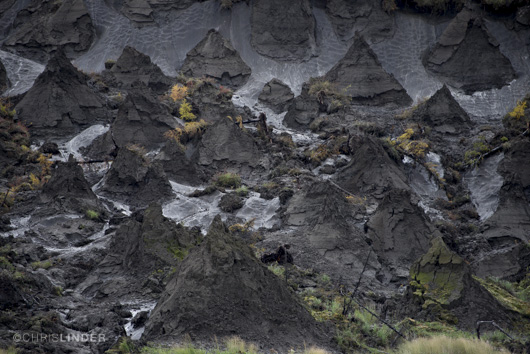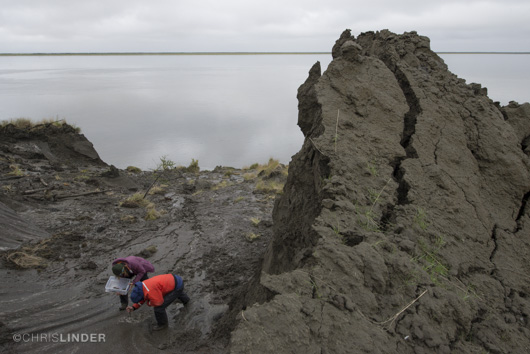In our first four days of being here, we’ve sampled about 15 sites, spanning streams and rivers all the way from Duvannyi Yar to the tundra. With summer coming to a close, we’ve decided to take advantage of the warm and mosquito-free days that this Siberian autumn has offered us with a whirlwind of boating and sampling adventures. Though it’s an amazing experience to come to Siberia with a big group of Polaris students, coming back as a returning student with a smaller, more focused group means we can accomplish loads of field and lab work in a short time. We also have more of an opportunity to interact with other scientists visiting the Northeast Science Station, American and Russian alike.

Ice wedges at Duvannyi Yar
On our trip to Duvannyi Yar we sampled ice wedges, permafrost, and ice wedge thaw stream water for both Carbon Bomb and for my experiments, plus a bit extra to play with and try some new procedures on once we finish setting up those projects, such as carbon dating gas samples and identifying ancient bacteria and viruses. Unlike last summer when we visited the Pleistocene-aged Yedoma permafrost cliff exposure of Duvannyi Yar, mosquitoes this time around were non-existent in the colder temperatures and we were able to sample and enjoy the site without the familiar clouding veil of mesh bug net. Because of exceptional flooding in Siberia, the sediment beach below the exposure where we found oodles of mammoth, bison, and horse bones in the past was under water, making bone hunting a bit trickier.

Kelsey Dowdy (left) and Rob Spencer carve out ice wedge samples at Duvannyi Yar
After sampling, Paul and Nikita jet further up the Kolyma to sample the Omolon River, a tributary of the Kolyma, while Rob and I visited a camp of Russian scientists. These scientists, from a university just outside of Moscow, were camping at Duvannyi Yar to hunt for squirrel burrows containing frozen seeds from the Pleistocene. They had previously found and successfully germinated tens of thousands of years old seeds, and during this trip to Duvannyi Yar they found several large bags worth of seeds. We spent the afternoon chatting with our new colleagues, being fed three delicious meals, collecting a few more samples, and planning out experiments.

Kelsey Dowdy (left) and Rob Spencer carve out ice wedge samples at Duvannyi Yar
As for my project, I’ve set up two experiments so far, all using Duvannyi Yar ice wedge thaw stream water. One experiment is looking at if ice wedge stream microbes and Kolyma river microbes actually prefer to eat old (~30,000 year old) “yummy” carbon over more modern, river carbon, and which microbes (ice wedge stream versus river) use each carbon source more efficiently. The second experiment is examining if microbes provided with juicy, old carbon gives them an energy boost and allows them to break down less delicious (i.e. river) carbon sources more quickly than the microbes would be able to if they weren’t stimulated with a shot of old carbon energy. This process of using an easy-to-eat carbon source to more effectively break down a hard-to-eat carbon source is called priming. The results will tell us if increasing additions of permafrost carbon due to climate change will help in degradation of stable modern carbon, resulting in even more carbon movement to the atmosphere.




Comments(3)-
-
Lisa Dowdy says
September 6, 2013 at 8:59 pmYour description of your project was clear and very interesting. I now actually understand what you’re doing! 🙂
Anita Hunt says
September 27, 2013 at 10:41 pmI am really interested in those germinated seeds! I would like to know more about the plant species that were found and what was done to coax them back to life.